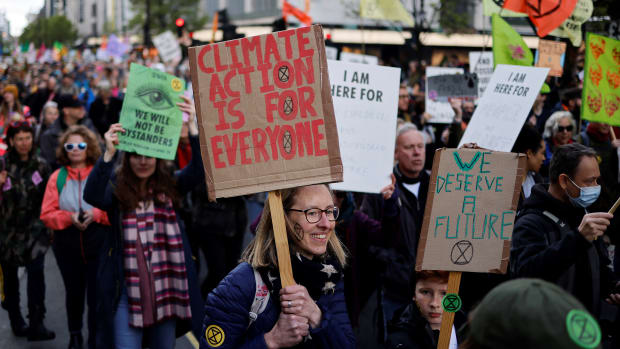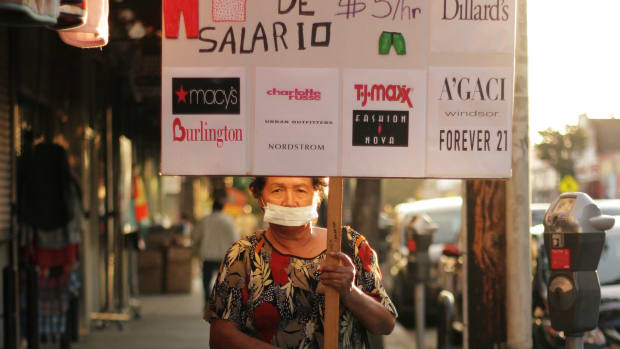
How A Fashion Bill Becomes A Law
 How a Fashion Bill Becomes a LawNew York State's proposed Fashion Act would be a revolutionary piece of legislation. Here's how it becomes reality.
How a Fashion Bill Becomes a LawNew York State's proposed Fashion Act would be a revolutionary piece of legislation. Here's how it becomes reality.- Author:Maura Brannigan
- Publish date:Apr 25, 2022
New York State's proposed Fashion Act would be a revolutionary piece of legislation. Here's how it becomes reality.
Fashion is dirty business. Facts and figures abound that prove how objectively harmful the industry is to the planet and its residents. Maybe you've even seen the statistics yourself: Between 4-8.6% of total global greenhouse gas emissions are produced by the apparel and footwear sectors, sectors that are largely made up of women and intricately linked with child and forced labor.
We can recite these data points until we're blue in the face (which, here at Fashionista, we often do). But still, we're frequently left asking where that leaves actual systemic change, the kind that's needed to make a semblance of a difference in the future — or rather, to ensure there will be a livable future at all.
The most compelling solution, experts argue, lies in our policy.
"It's wonderful if people on an individual level want to hold themselves accountable, but it shouldn't just stop there," Tori Curbelo, program director and co-founder for advocacy organization Fashion of Tomorrow, told Fashionista in June. "Where are our legislators? Where's the government?"
In Europe, new regulations are cropping up to do just that, with governmental agencies introducing significant, industry-wide oversight over its production, waste and labor practices. Perhaps most prominently is France's recent anti-waste law that bans the destruction of unsold clothes, with the threat of fines of up to 15,000 euros. The European Union, meanwhile, is waging its own direct affront against the fast-fashion machine, mandating that textiles sold within Europe must be longer-lasting and easier to repair.
So, where does the U.S. come in? To date, there's no one framework that holds domestic fashion businesses accountable for their supply chains. The closest thing we have to concrete policy is a piece of legislation called SB-62, which passed in September to make California the first state to penalize manufacturers and brands for labor violations, like wage theft and illegal pay practices. It's a big deal, to be sure, but despite serving as a significantly positive example for garment industries across the country, the law is still a local one.
Then, in January, a coalition led by New York State policymakers Sen. Alessandra Biaggi and Assembly Member Dr. Anna Kelles announced its Fashion Sustainability and Social Accountability Act, known more simply as the Fashion Act. Like SB-62, the legislation strives to hold fashion's biggest businesses — those with more than $100 million in global revenues and doing business in New York — accountable for matters environmental and social. This encompasses U.S.-based companies like Gap Inc., Tapestry and Capri Holdings, as well as, crucially, international brands, from fast fashion to luxury. If passed, the bill's influence would be seismic, affecting each rung of the industry's supply chain ladder not only stateside, but maybe even globally.
In practice, the Fashion Act strives to enact what the UN Guiding Principles on Business and Human Rights call a mandatory due diligence framework, the likes of which have already gotten a foothold in Europe. Under new regulation, companies will be tasked with not only disclosing their greatest areas of social and environmental impact, but also mapping out their strategies to lessen them.
What's in the Fashion Act?The Fashion Act is a weighty piece of legislation, with just as lofty a goal. To make it more digestible for lawmakers and businesses alike, Maxine Bédat, the executive director of think and "do" tank New Standard Institute, says drafters have separated the bill into three distinct parts. Firstly, the bill would require companies to report a minimum of 50% of its supply chains, beginning with the farms from which it sources its raw materials all the way up to with the vendors with which it partners for its shipping and distribution.
Secondly, brands would be tasked with setting new goals, then outlining strategies to achieve those milestones. In the case of climate-related matters (like emissions, energy and chemical management), all plans of action must be in accordance with science-based targets set in the Paris Agreement. Anything above those marks would be out of compliance with the law. As Bédat explains, it's not that companies aren't in support of such targets — it's just that they're not on their way to achieving them.
"Having this be a requirement in law will definitely kickstart that work between brands and their suppliers," says Bédat. "There are big celebrations of targets for 2050. But if you're not actually on your way and we won't know that until 2050, it's too late."
Bédat does mean that literally. The latest report from the UN's Intergovernmental Panel on Climate Change — released just days before my conversation with Bédat — is dire: Global emissions must peak by 2025 to even have a chance of meeting goals outlined in the Paris Agreement.
The Fashion Act is also concerned with labor. Brands would be tasked with disclosing median wages for workers and would be subsequently fined for non-compliance, with said fines going toward a community fund for environmental justice projects across New York State.
Scroll to ContinueRecommended Articles Sophie Buhai Is Hiring a Production Coordinator in Los Angeles, CA
Sophie Buhai Is Hiring a Production Coordinator in Los Angeles, CA How a Fashion Bill Becomes a Law
How a Fashion Bill Becomes a Law good light Is Seeking A Summer '22 Graphic Design Intern (Remote)
good light Is Seeking A Summer '22 Graphic Design Intern (Remote)Thirdly, there's the matter of waste. An estimated 92 million tons of global textile waste is created each year, with that figure expected to rise to 134 million tons by 2030. Under the Fashion Act, brands would be required to report their total material production volumes — a figure that's historically been kept hidden — and then make them available online.
How Does the Legislative Process Work?Bédat founded the New Standard Institute in 2019 — three years before the introduction of the Fashion Act — with the understanding that policy, specifically legislation, is a necessary tool to impart the kind of impact she's interested in leaving. She was already mapping out a bill when Sen. Biaggi entered the picture, and soon, the Fashion Act started taking shape.
Together, they began connecting with climate and labor leaders across the state, eventually bringing together a coalition of nonprofits and thought-leaders, including the Natural Resources Defense Council and New York City Environmental Justice Alliance, as well as designers like Stella McCartney and Mara Hoffman and celebrities such as Rosario Dawson, Jane Fonda and Leonardo DiCaprio. With the bill drafted and amended, it's now stationed in New York State's Consumer Protection Committee in the Senate and the Consumer Affairs and Protection Committee in the Assembly.
The Fashion Act then has to get on the agenda in Committee, and only after it's passed out of either Committee can it be brought to the floor for a vote. Ideally, this happens before the New York State legislature adjourns for the year in June. If the Fashion Act were to pass, it would go to Gov. Kathy Hochul, who has 10 days (not including Sundays) to pass or veto the bill.
To maximize the bill's appeal to pass out of Committee, the coalition has spent the last few months garnering feedback from stakeholders and legislators to prepare another draft. And that requires some good old-fashioned lobbying.
"Lobbying is just having a meeting," says Bédat. "That's what it is. Some organizations hire lobbyists that represent industries, and those are just people who knock on doors professionally. But any one of us can be lobbying for an idea by tweeting at their representative or going to Albany, and we actually must do that in order to achieve progress."
Their efforts may be paying off, as the outcome looks promising, with a number of members of the Committees already coming on to co-sponsor the bill. But it needs momentum — something SB-62 has helped with significantly.
"SB-62 was a demonstration that bills related to the fashion industry can get passed in the U.S.," says Bédat. "This idea that this is just an industry that forever will not be regulated began to be chipped away with SB-62."
Does Your Voice Really Matter?The coalition may be optimistic that the Fashion Act will make it out of Committee and onto the floor, but that's dependent on the engagement of its stakeholders, which include everyday advocates like you or me. Bédat finds that constituents, particularly those of millennial or Generation Z age, are growing exhausted — disengaged, even — with the lack of progress being made on a federal level in the climate and labor spaces.
"Your voice, especially on the state level, can matter a lot," she says. "And I hear this directly from the senators and the assembly members. If they get a call or a tweet or an email, they listen to that. There's a person on the other end that's actually reading, hearing, listening, and will very potentially change their vote as a result of that single conversation, exchange, interaction."
On Tuesday, the coalition heads to Albany for a rally at the New York State Capitol Building. (Interested parties can book their spot on the bus, leaving from New York City, here.) And while in-person lobbying is immensely important, there's other valuable means of participation, too. (Head to TheFashionAct.org for specific guidance on how to call, tweet or email New York State representatives.)
One call, one tweet or one email could be that one small step we need toward in a new, more viable future, according to Bédat.
"There's been a lot of conversations about how individual action, when it comes to purchasing practices, won't make the difference," she says. "But individual action in engaging as a citizen does, and is the thing that we need to make these systemic changes."
Stay current on the latest trends, news and people shaping the fashion industry. Sign up for our daily newsletter.
Tagsterms:labor rightsNetworkClimateEthical Fashionlabor reformNew Standard InstituteSustainable Fashionsustainability By Maura Brannigan
By Maura Brannigan
 NewsCleaning Up Fashion Starts With Policy Change
NewsCleaning Up Fashion Starts With Policy ChangeA new grassroots campaign is calling on lawmakers to make fashion a core part of the legislative agenda.
By Maura BranniganJun 14, 2021 BusinessIn Fashion, Regenerative Farming Isn't an Impossible Solution
BusinessIn Fashion, Regenerative Farming Isn't an Impossible SolutionEco-label Christy Dawn spent two years bringing 24 acres of depleted farmland back to life. Now, the brand is sharing the roadmap of how it did it.
By Maura BranniganJun 28, 2021 NewsProtection for Long-Exploited California Garment Workers Is Finally Signed Into Law
NewsProtection for Long-Exploited California Garment Workers Is Finally Signed Into LawThe Garment Worker Protection Act enforces fair compensation and holds fashion brands accountable for unpaid wages.
By Dhani MauSep 28, 2021 NewsInside the Fight to End Labor Exploitation in L.A. Garment Factories
NewsInside the Fight to End Labor Exploitation in L.A. Garment FactoriesGarment workers are working to change a long history of wage theft and sweatshop-like conditions in Los Angeles.
By Aditi MayerOct 13, 2020Loading…See More© 2022 Breaking Media, Inc. All rights reserved.Introducing Jobbguru: Your Gateway to Career Success
The ultimate job platform is designed to connect job seekers with their dream career opportunities. Whether you're a recent graduate, a seasoned professional, or someone seeking a career change, Jobbguru provides you with the tools and resources to navigate the job market with ease.
Take the next step in your career with Jobbguru:
Don't let the perfect job opportunity pass you by. Join Jobbguru today and unlock a world of career possibilities. Start your journey towards professional success and discover your dream job with Jobbguru.
Originally posted on: https://fashionista.com/2022/04/fashion-act-new-york-sustainability-bill